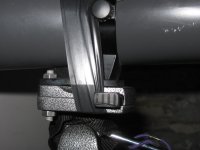aegithalos
Well-known member
I'm looking for a way to connect my scope to my tripod that does not involve a quick release plate. I have had these plates for a few years, and have never managed to connect the scope sufficiently tightly to the plate: it always worked loose. In the end, in desperation, I over-tightened the screw and damaged the thread in the scope's foot ... The fundamental problem seems to me to be that a scope that weighs a kilo or so, with perhaps 50cm leverage cannot be attached to something by one screw.
I have a solution involving a bungee cord that actually works quite well, but I am wondering if there is something better out there - I have failed to find it in several searches of various real and online shops.
I don't need a quick release plate. I have one scope and one tripod, and they stay together. If it takes 10 mins to connect and disconnect on the occasions when I fly, that is fine. What I do want is an absolutely rock solid connection. The scope must not move or vibrate by even the merest fraction, relative to the tripod head. Since the scope foot is usually bevelled in some way, I suspect that a solution involving some kind of clamp (and at least two, preferably three or more screws) ought to work. Or maybe a bracket that goes over the scope.
If anyone knows of any product that can do this, I would be extremely grateful ....
My current scope is Kamakura, tripod is Manfrotto, but either might change: I am looking for a general solution.
Cheers,
Keith
I have a solution involving a bungee cord that actually works quite well, but I am wondering if there is something better out there - I have failed to find it in several searches of various real and online shops.
I don't need a quick release plate. I have one scope and one tripod, and they stay together. If it takes 10 mins to connect and disconnect on the occasions when I fly, that is fine. What I do want is an absolutely rock solid connection. The scope must not move or vibrate by even the merest fraction, relative to the tripod head. Since the scope foot is usually bevelled in some way, I suspect that a solution involving some kind of clamp (and at least two, preferably three or more screws) ought to work. Or maybe a bracket that goes over the scope.
If anyone knows of any product that can do this, I would be extremely grateful ....
My current scope is Kamakura, tripod is Manfrotto, but either might change: I am looking for a general solution.
Cheers,
Keith






